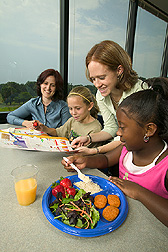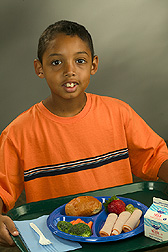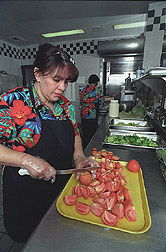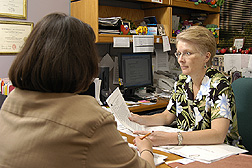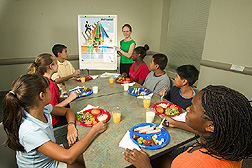Helping Schoolchildren Make the Grade in Nutrition
This month, schools nationwide are celebrating National School Lunch Week in honor of the USDA National School Lunch Program, which ensures that nutritious lunches are available to schoolchildren. Cafeterias participating in the National School Lunch Program served 4.8 billion lunches in 100,000 schools nationwide during fiscal year 2004.
About 29 million children participate in the program each weekday—well over the total number of people served daily by the nation’s largest fast-food chain. Supporting USDA’s efforts to promote the Dietary Guidelines for Americans, ARS research findings are proving the importance of children consuming these healthy school meals for optimal nutrition.
The federally funded National School Lunch Program ensures that students are able to obtain daily meals that provide a weekly average of one-third or more of the Recommended Dietary Allowances for protein, iron, calcium, and vitamins A and C. But there are challenges.
Perhaps the biggest challenge comes from foods and beverages served outside of the USDA school meals program, which are not subject to the same stringent nutritional requirements. Contrary to popular perception, the federal government’s restrictions on foods served outside the federally reimbursable school meals programs are very limited at this time. During mealtimes, only four classes of food—sodas, water ices, chewing gums, and certain candies—are restricted from being served. That yields broad local control over selling other foods—which may have little nutritional value.
Competition From “Outside Foods”
Foods and beverages that are served outside of any reimbursable school meal are sometimes referred to as “competitive” or “additional” foods when they are served during the same time as a school’s federally reimbursable meal.
Depending on a particular school district, foods competing for a child’s appetite might include fast food staples such as super-sized pizza portions and deep-fried food dishes served every day. These competitive foods, depending on locality, are available from à la carte sales, vending machines, school stores, canteens, snack bars, and fundraising sales.
But importantly, ARS research shows that USDA school meal programs are good for students’ nutritional health. A recent study highlights the importance of National School Lunch Program meals to fruit, vegetable, and milk consumption among children in elementary and middle school.
ARS-funded behavioral nutritionist Karen Cullen and colleagues collected and studied four lunch-food records provided by nearly 600 students while they were in the fourth and fifth grades. Cullen is a registered dietitian at the USDA-ARS Children’s Nutrition Research Center at Baylor College of Medicine in Houston, Texas.
The study showed an important change when the students entered fifth grade—and gained access to school snack bars. At that time, they consumed fewer fruits and regular, nonfried vegetables and less milk than they did the previous school year, when they had access only to meals served through the National School Lunch Program. The fifth-graders also consumed more sweetened beverages and fried, or high-fat, vegetables after gaining access to the school snack bar, which occurred during the second year of the 2-year study.
“These data contradict the popularly held belief that school lunches are not nutritious,” said Cullen. “And it shows that meals from the school lunch program can contribute to controlling excess intake of foods of little nutritional value.”
The 2004 study was published in the American Journal of Public Health and was supported in part by a grant from the Cancer Research Foundation of America.
While school meal policies—which address foods sold at lunchtime—are largely subject to local control, increasing numbers of state legislatures and agencies are requiring that all foods available in schools, including competitive foods, meet strong nutritional standards, as USDA school meals are required to do.
|
|
Fast, But Not Nutrient Friendly
On an average schoolday, more than half of the nation’s schoolchildren reach for a USDA-subsidized school meal. Those meals are served either “free,” at a “reduced price,” or at a still-subsidized “full price.” But while all these students could opt to purchase one of these nutritious meals, many instead are tempted into reaching for accessible à la carte or other foods, which often serve up quickly.
ARS research has shown more than once that fast-food consumption is implicated in poor nutrition among children.
An ARS study published in 2004 reported that kids who ate fast food, as compared with kids who didn’t, ate more total calories, drank less milk, and ate less fiber, fruit, and nonstarchy vegetables than their counterparts. Study author and ARS food scientist Shanthy Bowman is with the ARS Community Nutrition Research Group, which is part of the Beltsville [Maryland] Human Nutrition Research Center.
All Healthy School Policies Are Local
As a part of the 2004 Child Nutrition Reauthorization Act, each local school district participating in a USDA school meal program is required to establish a wellness policy by the beginning of the 2006-2007 school year. Representatives of local education agencies and school food authorities will be collaborating with parents, students, teachers, school board representatives, school administrators, and the public to develop the local wellness policies.
At a minimum, these local policies must include setting goals for nutrition education, physical activity, and school-based health activities that promote student wellness. They must also include local nutrition guidelines for all foods and beverages made available on school campuses. In addition, the new law requires that there be one or more designated individuals within each local education agency, or within each school, to ensure that the goals of the local policies are met.
Whether part of the USDA school meal program, or competitive foods sold or served, these changes are heating up local interest in serving up the healthiest school meals possible. And ARS is poised to help. Anyone affiliated with the National School Lunch Program nationwide is eligible to access customized resource materials from a unique part of ARS—one of America’s four national libraries.
A Library of Food Resources
The National Agricultural Library (NAL) in Beltsville, Maryland, manages the world’s largest and most accessible compilation of agricultural research findings. It also hosts more than 60,000 web pages, such as the Healthy School Meals Resource System (HSMRS). This custom website caters to anyone who works with USDA’s child nutrition programs nationwide.
HSMRS is a project of the library’s Food and Nutrition Information Center, an Internet-oriented service group of registered dietitians and nutrition-information specialists geared to rapidly responding to the nutrition concerns of the nation’s consumers and healthcare providers.
HSMRS provides nutrition information, foodservice training, and other support services. The center’s web-based resources include searchable databases, such as a directory of consulting chefs who will visit schools; studies and reports; and interactive tools.
Cafeteria of Custom-Made Materials
One of the most valuable assets of HSMRS is a unique collection of training materials developed by state agencies that administer the National School Lunch Program. Since 1995, state agencies have received USDA Food and Nutrition Service “Team Nutrition” training grants to develop materials that assist school foodservice staff.
“State agencies agree to share the valuable resources they develop under these grants,” says Desiré Stapley, a registered dietitian who heads HSMRS. “Many of these high-quality resources are available electronically, for example by downloading resources or printing web pages.”
These downloadable materials include full-text training programs on food service, food-safety resources, and nutrition-education materials for classroom teachers. They also include school lunch menu ideas for the best ways to provide tasty, enticing meals that meet nutritional requirements.
Checking Out Recipes for Success
Anyone in the country can obtain NAL print materials locally through an interlibrary loan with a participating private or public library. But the HSMRS materials are directly available to those who work with school meals through an “Expanded Service Patrons” program. These customers include school foodservice professionals, principals, librarians, school nurses, and teachers.
“We are here to serve an estimated 1 million people who are involved in the National School Lunch Program,” says registered dietitian Corey Scarpero, an NAL healthy school meals team member. “Even parents and other volunteers who want to improve the tastiness, quality, and awareness of school meals served locally can team up with an Expanded Service Patron to identify and borrow these valuable resources directly.”
The library will ship materials requested by Expanded Service Patrons without charge. Borrowers need only pay for return shipping of materials as well as insurance. The privilege includes direct, 30-day borrowing access to materials, which include videotapes and multimedia kits containing manuals, posters, CD-ROMS, puppets, and food models.
The materials can be searched on the Internet through NAL’s online bibliographic database, AGRICOLA, at agricola.nal.usda.gov. The HSMRS can be accessed at schoolmeals.nal.usda.gov.—By Rosalie Marion Bliss, Agricultural Research Service Information Staff.
This research is part of Human Nutrition, an ARS National Program (#107) described on the World Wide Web at www.nps.ars.usda.gov.
To reach scientists mentioned in this article, contact Rosalie Bliss, USDA-ARS Information Staff, 5601 Sunnyside Ave., Beltsville, MD 20705-5129; phone (301) 504-4318, fax (301) 504-1486.
"Helping Schoolchildren Make the Grade in Nutrition" was published in the October 2005 issue of Agricultural Research magazine.







